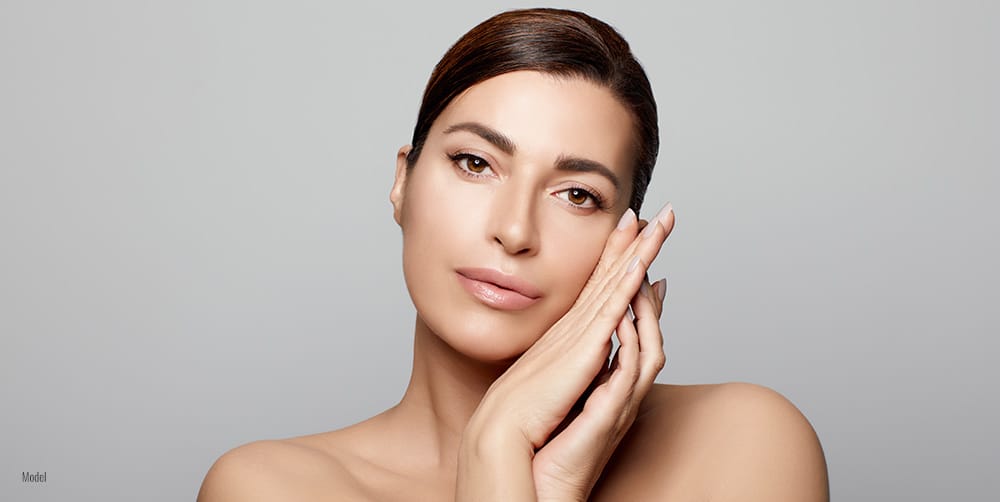Posted August 08, 2024 in Beauty, Blog, Ulthera

For those who desire skin tightening and lifting without surgery, Ultherapy is an excellent option. Like many non-surgical procedures, Ultherapy can be combined with other cosmetic treatments to enhance results and achieve the desired aesthetic. This blog will specifically discuss the combination of Ultherapy with dermal fillers, including what to expect and which treatment to do first.
6 Min Read:
What Is Ultherapy®?
Many want to look their best, but the most effective procedures and options aren’t always commonly known. Ultherapy® is a non-invasive skin tightening treatment designed to lift and tighten the skin and muscles of the face, neck, chin, and brow areas and reduce wrinkles on the decolletage. The treatment’s bonus benefit is improved skin color, tone, and texture. The treatment uses microfocused ultrasound (MFU) technology to gently warm the skin and deeper tissues, muscle lining (SMAS), and stimulate new collagen production. With the increasing demand for less-invasive aesthetic procedures, patients love this non-surgical facelift option and its profound results. Dr. Persky likens Ultherapy to a “Judy Jetson” face/neck lift, with reference to the 1960s futuristic cartoon TV show, The Jetsons.
How Long Does Ultherapy® Last?
The collagen stimulation induced by Ultherapy® treatment continues to increase over three to nine months following the procedure. Dr. Persky has patients who have returned up to five years after their single treatment, and they are still looking better than they did before their Ultherapy. The aging process does continue, but after Ultherapy, you will look better for the rest of your life than if you never had the treatment. Some patients opt for repeat maintenance treatments every one to four years, while others are satisfied with a single session.
What Are Fillers?
Dermal fillers are injections of gel-like substances formulated to smooth lines and wrinkles and restore volume to the face. There are various dermal fillers, usually centered around a particular ingredient, hyaluronic acid, calcium hydroxylapatite, or poly-L lactic acid. Regarding the best facial regions to place fillers and other injectables, Dr. Perskly has a guide detailing filler types and corresponding facial areas. Dr. Persky uses his decades of experience to place the proper filler in the correct place to ensure his patients look their natural best. His philosophy is that “No one should know!” that you have had any work done.
Hyaluronic Acid (HA)
You may recognize this popular filler, increasingly marketed as a main ingredient in skincare and cosmetics. HA naturally occurs in the human body and plays a vital role in hydration, as it is a compound that may attract up to 1000 times its weight in environmental moisture. This makes it an excellent ingredient for dermal fillers. Hyaluronic acid fillers usually last six months to two years, depending on the product and the location. Recent MRI studies have shown that these fillers may last many years more.
Examples of brands of filler that use HA are JUVÉDERM® and Restylane®.
Calcium Hydroxylapatite (CaHA)
This substance is found in human bones and is great for replacing lost bony facial structure and restoring youthful facial contours. CaHA can stimulate long-term collagen production. Results tend to last about a year to two years. CaHA is often hyperdiluted (mixed with prp and local anesthesia), which converts it from a filler to a regenerative collagen/elastin volume stimulator. Hyperdilute CaHA is an excellent treatment for rejuvenating crepey skin of the face, neck, decollete, arms, and buttocks.
Radiesse® is the only FDA-approved CaHA filler on the market.
Poly-L-Lactic Acid (PLLA) (Sculptra(™))
This natural sugar has been used in the medical industry for decades as a dissolvable surgical suture. As a bioregenerative stimulator, it aids collagen production and natural gradual volume replacement. Historically, PLLA was first used in 2000 for the treatment of lipoatrophy, or fat loss in HIV patients. It was FDA-approved for aesthetic use in 2004. A nice additional benefit of Sculptra is the “Sculptra Glow.” Patients’ skin tone, texture, and color improve with a natural glow. The results from this filler can last two years or longer. Once patients have reached correction with their Sculptra treatment, they won’t need maintenance for 2 to 7 years. Dr. Persky is a clinical instructor in the use of PLLA, HA, and CaHA. An example of a filler brand that uses PLLA is Sculptra®.
Can I Combine Ultherapy® With Fillers?
In short, yes, Ultherapy® can be combined with dermal fillers for a synergistic effect. In other words, 1+1 is more than 2. Often, the combined therapy produces multiple times the results of each individual treatment as a stand-alone. However, there is an art and science to integrating both treatments.
It is not advised to use Ultherapy® on an area previously treated with hyaluronic acid fillers because the ultrasound energy could cause the fillers to disintegrate sooner than intended. When used at the same time, Ultherapy is performed first; then, fillers are strategically injected where needed. In the case of excess filler swelling, particularly around the eyes (malar edema), Ultherapy may be combined with hyaluronidase to decrease the swelling. Ultherapy will not dissolve Sculptra or CaHA.
Which one should I do first?
Ideally, a patient will receive Ultherapy® treatment first. The ultrasound technology stimulates collagen production, which increases over several months. It is recommended that patients wait out this period to see how results are emerging and then to determine if further treatment is required. After satisfactory skin tightening and lifting, hyaluronic acid dermal fillers can be injected to perfect the look. Ultherapy is often combined with Sculptra and hyper-dilute Radiesse in the same session for best results.
What’s the best filler to combine with Ultherapy®?
Dermal fillers have different formulations that address different facial regions and cosmetic concerns. Dr. Persky can recommend the best dermal filler for you.
Generally, poly-lactic acid fillers, such as Sculptra®, are ideal for combining with Ultherapy®. Both of these treatments achieve results that increase over time. Ultherapy® helps to lift the face, brows, and cheeks, defines the jawline, and corrects sagging skin of the jowls and neck, whereas PLLA fillers can restore volume to the entire face, further eliminating signs of aging. These treatments can create a naturally beautiful, uplifted, and youthful appearance.
As stated by Dr. Persky, MD, Persky Sunder Facial Plastic Surgery, Encino
Points from the Video:
00:05- There are patients who ask about having ultherapy after having facial fillers;
00:34- How after sculptra, one may have ultherapy;
01:10- It is recommended to go in for ultherapy prior to fillers;
How Much Does Ultherapy® Cost in Los Angeles?
The cost of Ultherapy® depends on the areas treated, the number of sessions needed, and other factors. Dr. Persky can give you exact pricing information at the time of your consultation.
Have More Questions About Combining Ultherapy and Fillers in Los Angeles?
We have answers! Call us at 818-501-3223 or fill out our online contact form to schedule a consultation.




